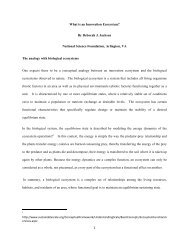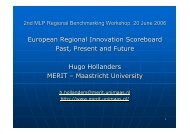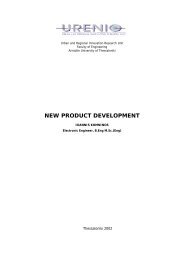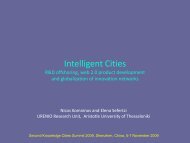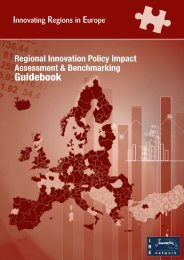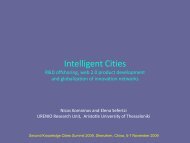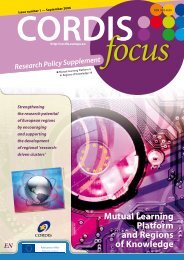Creating smart systems, guide to Cluster strategies in less favoured
Creating smart systems, guide to Cluster strategies in less favoured
Creating smart systems, guide to Cluster strategies in less favoured
Create successful ePaper yourself
Turn your PDF publications into a flip-book with our unique Google optimized e-Paper software.
A GUIDE TO CLUSTER STRATEGIES IN LESS FAVOURED REGIONS | 9<br />
rates <strong>in</strong> <strong>in</strong>dustrialised nations along with dim<strong>in</strong>ished <strong>in</strong>terest among youth <strong>in</strong> pursu<strong>in</strong>g<br />
<strong>in</strong>dustrial careers, have <strong>in</strong>creased the pressures <strong>to</strong> locate where a labour pool already<br />
exists.<br />
Industry leaders. Beh<strong>in</strong>d every successful cluster is a group of <strong>in</strong>novative firms led by<br />
people, who value learn<strong>in</strong>g, are committed <strong>to</strong> their community and, therefore, are will<strong>in</strong>g <strong>to</strong><br />
work <strong>to</strong>ward a collective vision for their <strong>in</strong>dustry. These lead<strong>in</strong>g companies may have a<br />
niche or rapidly grow<strong>in</strong>g market that is not threatened by competition, or it may face such<br />
<strong>in</strong>tense global competition that the benefits of mutual support and learn<strong>in</strong>g<br />
outweigh concerns about confidentiality. The key <strong>to</strong> build<strong>in</strong>g and susta<strong>in</strong><strong>in</strong>g a cluster<br />
organisation often rests with the support of these benchmark companies.<br />
Talent. Regions are beg<strong>in</strong>n<strong>in</strong>g <strong>to</strong> use <strong>in</strong>centives <strong>to</strong> recruit talent as they once recruited<br />
branch plants. Universities want faculty who will attract research dollars and bright<br />
graduate students, and clusters—especially <strong>in</strong> knowledge <strong>in</strong>tensive sec<strong>to</strong>rs—need bright<br />
young people <strong>to</strong> attract other new firms and young companies. Talent is attracted not just<br />
by salaries but by the chance <strong>to</strong> <strong>in</strong>teract with peers <strong>in</strong> their field, opportunities for<br />
professional development, and membership <strong>in</strong> local professional associations. Less<br />
advantaged and peripheral regions (or even low-<strong>in</strong>come communities <strong>in</strong> relatively<br />
advantaged regions) have trouble keep<strong>in</strong>g their best and their brightest graduates from<br />
mov<strong>in</strong>g <strong>to</strong> the “cool” places that can offer recreation activities, high culture, choices of<br />
good jobs, and that cater <strong>to</strong> diversity.<br />
Tacit knowledge. Successful regions are home <strong>to</strong> <strong>in</strong>stitutions, <strong>in</strong>dividuals, and<br />
organisations that serve as s<strong>to</strong>rehouses and dissem<strong>in</strong>a<strong>to</strong>rs of undocumented knowledge.<br />
The knowledge resides <strong>in</strong> research and technology centres and their staff, educational<br />
<strong>in</strong>stitutions and their faculty, and companies and their employees. It extends well beyond<br />
whatever may be recorded. Those that develop and work with new technologies,<br />
techniques, and <strong>systems</strong> know far more about how it works under a variety of<br />
circumstances than is ever documented.<br />
IV. Barriers Fac<strong>in</strong>g <strong>Cluster</strong>s <strong>in</strong> Less Favoured Regions<br />
Various his<strong>to</strong>ric under-<strong>in</strong>vestments limit clusters <strong>in</strong> <strong>less</strong> <strong>favoured</strong> regions from ga<strong>in</strong><strong>in</strong>g new,<br />
or hold<strong>in</strong>g on<strong>to</strong> exist<strong>in</strong>g, competitive advantages. Most can be traced <strong>to</strong> a weak<br />
<strong>in</strong>frastructure; lack of access <strong>to</strong> capital, technology, <strong>in</strong>novation, and capital; regional<br />
<strong>in</strong>sularity and isolation; low educational levels and low skilled work force; absence of<br />
talent; and an overly mature or hierarchical <strong>in</strong>dustry structure. Social exclusion exists <strong>in</strong><br />
places with large and isolated underprivileged and undereducated populations;<br />
technological exclusion exists <strong>in</strong> places with poor access <strong>to</strong> sources of technology and<br />
benchmark companies; and economic exclusion is a result of weak l<strong>in</strong>ks <strong>to</strong> benchmark<br />
regions and markets.<br />
Deficits <strong>in</strong> physical <strong>in</strong>frastructure. Infrastructure deficits create an uneven play<strong>in</strong>g field<br />
for regions that <strong>in</strong>hibit capital <strong>in</strong>vestment. The digital divide has become a rally<strong>in</strong>g cry <strong>to</strong><br />
br<strong>in</strong>g broadband capabilities <strong>to</strong> even the most rural areas. But locations where the<br />
transportation of goods and people are costly and <strong>less</strong> frequent pose even more severe<br />
handicaps on regions that are difficult <strong>to</strong> remedy. As time <strong>to</strong> dest<strong>in</strong>ation and logistics<br />
become more important <strong>to</strong> cus<strong>to</strong>mers, poor access <strong>to</strong> transportation becomes more of a<br />
barrier.




